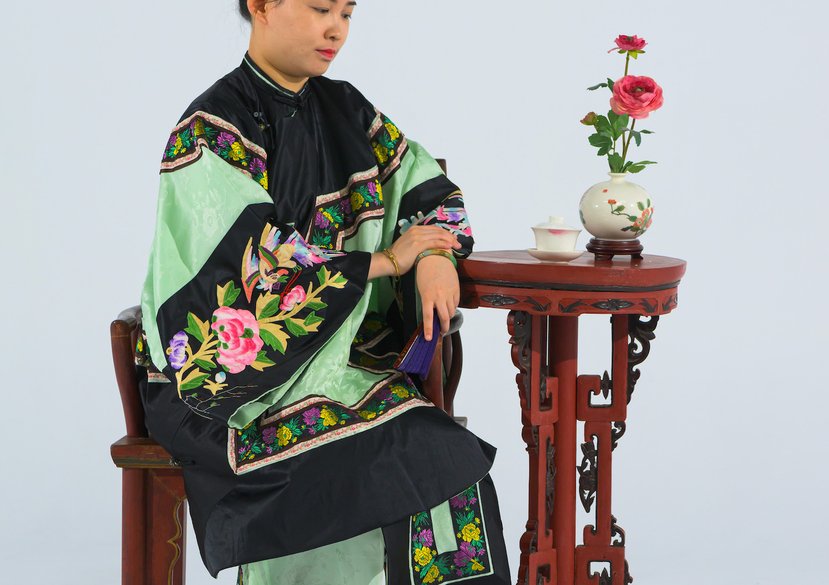
Framing Devices: The Production and Consumption of Woven Ribbon Borders in Late Qing Women’s Clothing
Woven silk ribbons featuring colourful designs such as butterflies and pomegranates border all sorts of women’s garments from the mid-Qing dynasty (Qing dynasty r. 1644-1911) onwards, framing jackets, trousers, and even lotus shoes. Cheaper than embroidered or woven fabric, these ribbons were popular with both Han and Manchu women, and allowed a wider consumer base to embellish their clothing. This project will explore how ribbon borders were produced, how they served to embellish fashionable clothes, and how changing patterns of use reflected changes in the fashions and values of the late Qing (1860-1911). Surviving objects and textual sources such as commercial records will be used to discern the role of ribbons in the fashion system of late Qing China and investigate how and why it was ribbons that framed the modern Chinese female body. Before the 20th century, most ribbons were produced domestically; however, as trade with Western powers flourished, foreign-produced ribbons started to be incorporated into women’s clothing. I will combine analysis of visual culture, literary and economic sources, and study of extant objects in the V&A (London) and Chinese Textiles and Clothing Culture Center (Taipei), making sense of how these ubiquitous trimmings were used in the Chinese fashion system and how increased globalization and commercialization affected the fashions of Chinese women in the late Qing.
Key details
School, Centre or Area
Area of expertise
Supervisors
Funding
Personal links
Gallery
More about Laurence Wen-Yu
Biography
Laurence is an AHRC and Taiwan Ministry of Education funded PhD student in the History of Design program at the Royal College of Art and the Victoria and Albert Museum. Her research centres around cultural studies of ribbons on late Qing (1860-1911) Chinese women’s clothing. Other interests include the use of reconstruction as a methodological approach in the field of historic Chinese dress. Laurence holds a BA from National Taiwan University and a MS in Textiles and Clothing from Fu Jen Catholic University. She is particularly interested in making research regarding historic Chinese dress more accessible to a global English-speaking audience and has written and presented a series of publicly-available videos titled Chinese Clothing Through the Ages.
Degrees
MS in Textiles and Clothing, Fu Jen Catholic University, 2023
BA National Taiwan University, 2019
Awards
Government Scholarship to Study Abroad, Taiwan Ministry of Education
Industry-Academia Collaboration Scholarship, Tri-Mountain Corp. & Fu Jen Catholic University
Funding
LAHP AHRC Research Studentship, 2023-2026
Publications
Li, L. W. (2023). Reconstructing Late Qing Han Chinese Women’s Dress through Making and Wearing. Paper presented at IFFTI 2023 Conference, Dunedin, New Zealand.
Li, L. W., Ho, Z. H., Wang, T. Y. (2021). From Collar to Hem: Comparison and Analysis of Construction Methods used in 6 Late Qing Dynasty Hakka Blouses [從領口到衣襬:六件晚清臺灣藍衫的服飾細節比較初探]. Paper presented at the 2021 Orange Beneficence International Conference, New Taipei City.
Research outputs
Chinese Clothing Through the Ages (video documentary series): https://www.youtube.com/playlist?list=PLHRBru6aIEfM0OMz7ycD6XDfphNZzAufS
Conferences
Li, L. W. (2023). The Bilingual Project: Challenges and Rewards of Presenting Reconstruction of Chinese Dress to an English-Speaking Audience [Conference presentation]. Making Historical Dress Network Workshop, Chawton, UK.
Li, L. W. (2022, November 24-25). Examining a Late Qing Han Chinese Women’s Ensemble through Reconstruction [Conference presentation]. Sichuan and Fu Jen University 2022 Conference, New Taipei City, Taiwan.
